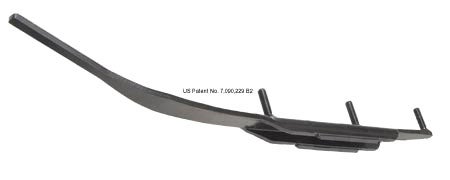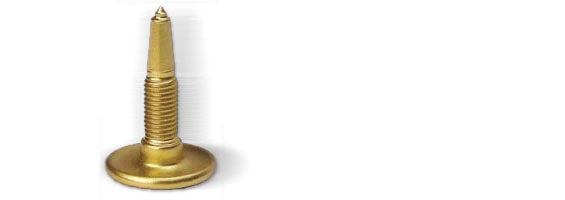Getting more traction out of your sled

What to consider when studding your track
In the old days it was enough to buy almost any brand of sharp-edged traction product and head out to the garage and stud your track. Back then a lot of stud technology consisted of rip-off designs of each other and the only real difference was in the quality of the metal used in the stud and backer plates. In a lot of small towns you usually could get traction studs at your local hardware store. Or, make some yourself from tempered screws or bolts.
Those days are gone. If you don’t pay attention when adding traction products to modern snowmobiles, you could literally rip out the tunnel of your sled. Ouch! And it’s best to know whether you can even add studs to your current model. Some sleds, like those early 2003 Ski-Doo REVs, weren’t designed to accommodate traction products at all. They could be adapted, but you needed some expert insight as to what specific products worked and how you had to have them installed.
In the good, old days, most tracks were similar enough that most traction products would fit them without modification. In recent years the sled manufacturers have developed brand-specific snowmobile tracks that can vary in overall width, thickness and height profile. Guessing isn’t going to work. You need to know specifics and ask for specific traction products.
While we certainly understand the advantages traction products can make for braking performance and cornering, not every state or province shares the belief that traction products are beneficial. For example, Minnesota bans sleds with studded tracks from some public snowmobile trails. One major north-south trail provides an alternative route for stud-equipped sleds, but not all routes are as generous.
 Stud Boy Power Points offer a lightweight and durable design with 60 degree carbide point for superior penetration and durability.
Stud Boy Power Points offer a lightweight and durable design with 60 degree carbide point for superior penetration and durability.
Before you add traction products, you need to understand whether or not areas where you ride permit traction products or not. You need to think about how aggressively you want to stud your track. Do you plan to race and need a lot of traction, or are you a casual rider looking to add a margin of safety?
We figure that the vast majority of us want traction products for the added safety margin they provide. A studded track is good when you encounter icy trails, especially when going into narrow, tight turns. You can get a confidence boost knowing that your sled will go where you point it and that if you do get a bit out of shape that the studs will cut your braking distance.
Now, let’s say that we are looking for modest traction. That can mean anywhere from 70 to 100 studs. Generally most trail riders with standard length tracks will opt for 72 to 96 studs strategically aligned on the track.
Way back when, you had to decide the pattern yourself. Fortunately, traction makers like Stud Boy (Liberty Products) and Woody’s (International Engineering) take the guess work out of traction. You can request a product catalog or simply go on the Internet and seek out your information right from the source. Most top traction suppliers will offer a help line or the opportunity to email for assistance.
One common sense issue you may consider, especially if you have been riding for a short time, is how to balance your sled for the trail. Simply adding studs to the track is only one part of balancing your sled’s handling.
 Woodys new Slim Jim Dooly embodies the anti-dart and adds superb cornering control. The new runner is available in 4, 6 and 8 inches of 60° turning carbide.
Woodys new Slim Jim Dooly embodies the anti-dart and adds superb cornering control. The new runner is available in 4, 6 and 8 inches of 60° turning carbide.
For example, say that you add studs to the track but leave the ski carbide stock. You may well find that the track now overpowers the front and the skis won’t bite in the turns. This ‘push’ means you don’t have enough turning carbide on your skis. You can remove some track studs or add longer turning carbide on the skis, or you may need to play with both. But, be careful you don’t go too aggressive on the ski carbide. Too much bite and your rear end will get loose in the turns. As you can see, there can be a fine line to tuning your sled’s set up.
And that doesn’t even take into account changing trail conditions. One time we thought we had set up a racing sled just perfectly. We finished second in the qualifying heats. It was a cold, brittle day when we started and we were happy to make the finals. We went off and socialized, drank coffee and left our traction set up as it was at the end of the heat. Well, in the interim, the track got beat up from all the day’s action, the sun had come out and warmed the ice, and by the time the finals rolled around, we discovered that what had been a good traction set up for the first few races was totally wrong for the finals. We finished — far back!
What we’re trying to explain is that you can have a perfect setup for part of a day’s ride, but it can change on you for a variety of reasons. Trail conditions can change from morning to afternoon or evening — especially in the springtime. Your traction set up can evolve depending on how many rocks and stones you may ride over. Even the best traction product won’t last if you like to ride in the brown parts of the trail, cross over a number of highways, ride into paved lots, or traverse rocky sections of a creek. Check your sled’s ski carbides and look for missing or damaged studs in the track.
 Woodys famed Gold Digger Traction Master studs are through-hardened, heat treated and feature a sharp 60° carbide tip that offers superb traction and durability on hard-pack snow and ice.
Woodys famed Gold Digger Traction Master studs are through-hardened, heat treated and feature a sharp 60° carbide tip that offers superb traction and durability on hard-pack snow and ice.
When you go to add traction products, you’ll want to know the specifics about your sled’s track. What is the lug height? Does your specific sled model come with adequate tunnel protectors? Does your sled’s manufacturer have a specific recommendation for studding?
In general a trail rider should use studs that don’t extend more than 3/8ths of an inch beyond the lug profile. If you are in doubt about what fits your sled, talk with your dealer’s service department. You don’t need to have them do the work for you, but they are best equipped for it. Adding traction products is relatively simple enough to do in your garage. When you get the stud makers catalog, you’ll note a variety of studs. For the best wear, we’d suggest the tried and true carbide tipped versions for the trail and leave the most aggressively tipped steel studs to the racers. Don’t forget to match turning power to the increased traction added at the back.
If you are comfortable with a power drill and a wrench, we’d suggest upgrading to traction products yourself. Both Woody’s and Stud Boy offer helpful sites with good product information and tips. You can get everything you need for the job from either manufacturer and we can personally verify the quality of the products, having ridden sleds fitted with both brands.








 Your Privacy Choices
Your Privacy Choices